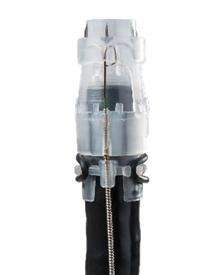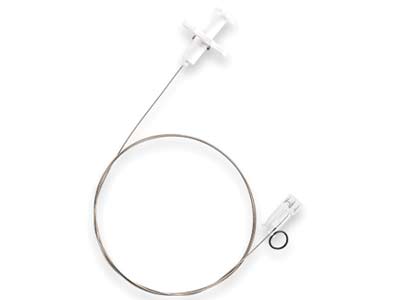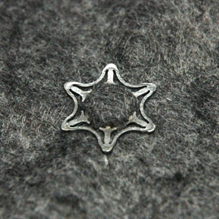FAQs
What is an endoscopic clip?
Endoscopic clips, also commonly referred to as hemostatic or colonoscopy clips, are suitable for various clinical applications and widely used in GI endoscopy to treat bleeds and tissue defects. A tissue defect is a broad term for perforations, anastomotic leaks, ulcers, fistulas, and resection sites.
How do you use an endoscopic clip?
Endoscopic clips provide closure by mechanically compressing tissue. The Padlock Clip defect closure system provides full circumferential approximation by encircling the defect, folding, and shortening the gathered tissue towards its center.
Before deployment, the endoscopic clip is positioned within the delivery system housing mechanism referred to as a tissue chamber. The tissue chamber draws targeted tissue into an ideal position for endoscopic clip placement.
As deployment is initiated, the clip prongs pierce the target tissue in a circle around the defect, holding it securely. During this piercing, tissue controllers on the prongs limit penetration depth. As the clip clears the delivery system housing, the prongs pull inwards towards each other as they radially compress the secured tissue towards its center. The tissue controllers and gaps between the prongs moderate tissue-on-tissue pressure while effectively closing the defect.
 Padlock Clip Pro-Select
Padlock Clip Pro-Select
Defect Closure System
How big is a hemostatic clip?
Hemostatic clips range in size. The Padlock Clip defect closure system is offered in two forms: the Padlock Clip defect closure system and the Padlock Clip Pro Select® defect closure system. The Padlock Clip system is for endoscopes with tip diameters ranging from 9.5mm to 11mm. The Padlock Clip Pro-Select system is for endoscopes with tip diameters ranging from 11.3mm to 14mm. Once deployed, the Padlock Clip measures 19mm from end to end.
How long do endoscopic clips stay in?
How long an endoscopic clip is retained depends on the amount of tissue captured (mucosal vs. submucosal vs. full thickness), native tissue response, and patient medical history. The Padlock Clip system may pass naturally after the defect has healed. Documented Padlock Clip system retention has ranged from one month to two years after placement.5 Through-the-scope clips are also designed to remain in patients long enough to allow healing, but anecdotal reports show some have remained in patients for years.
Do endoclips need to be removed?
While physicians have used many techniques with varying degrees of success, endoclips are not intended to be removed once placed. The same is true for through-the-scope clips and over-the-scope clips. One experiment in an animal model reported removing the Padlock Clip system with a snare.6
Are endoclips MRI conditional?
The Padlock Clip system is labeled MR conditional – a patient can be safely scanned in an MR system with a static magnetic field of 1.5. and 3 Tesla*
|
A patient with this device can be safely scanned in an MR system meeting the following conditions. Failure to follow these conditions may result in injury to the patient.
|
|
Non-clinical testing has demonstrated the Padlock Clip® defect closure system and Padlock Clip Pro-Select® defect closure system implants are MR Conditional
|
|
Name/Identification of device
|
Padlock Clip® defect closure system
Padlock Clip Pro-Select® defect closure system
|
|
Nominal value(s) of Static Magnetic Field [T]
|
1.5T and 3.0T
|
|
Maximum Spatial Field Gradient [T/m and gauss/cm]
|
19T/m (1900 gauss/cm)
|
|
Maximum MR System Whole-Body averaged specific absorption rate (SAR) [W/kg]
|
2.0 W/kg
|
|
Limits on Scan Duration
|
Under the scan conditions defined above, the device is expected to produce a maximum temperature rise of less than or equal to 3°C after 15 minutes of continuous scanning.
|
|
MR Image Artifact
|
In non-clinical testing, the image artifact caused by the device extends radially up to 0.6cm and 0.9cm (respectively) from the device when imaged with a gradient of echo pulse sequence in a 1.5T MR system and a gradient echo pulse sequence in a 3.0T MR system
|
WARNINGS AND PRECAUTIONS:
Precaution: It is recommended that healthcare providers distribute Patient Implant Cards with the name of the clip and date it was placed.
Warning: Failure to follow the recommended MR Conditional labeling may result in a deployed GI hemoclip dislodging from tissue or heating of tissue at the GI hemoclip location. A GI hemoclip dislodgement may result in rebleeding requiring additional intervention or surgery, serious injury, or death.
5 https://www.wjgnet.com/1007-9327/full/v21/i48/13587.htm
https://www.ncbi.nlm.nih.gov/pmc/articles/PMC7707885/
6https://www.thieme-connect.com/products/ejournals/abstract/10.1055/s-0030-1255620
 United States
United States
 Canada (EN)
Canada (EN) Canada (FR)
Canada (FR) Deutschland
Deutschland Italia
Italia United Kingdom
United Kingdom Australia
Australia New Zealand
New Zealand Singapore
Singapore Brasil
Brasil México
México






